Château Blaignan is a property of CA Grands Crus, the wine branch of the bank Crédit Agricole. It is located in the place of the former village of Blaignan that only keeps the privileged position of, on two limestone hills that offer varied situations of slopes and exposures. Anne Le Naour, deputy general manager and enologist of the CA Grands Crus propertis, opened the doors of Blaignan to Nelson Chow.
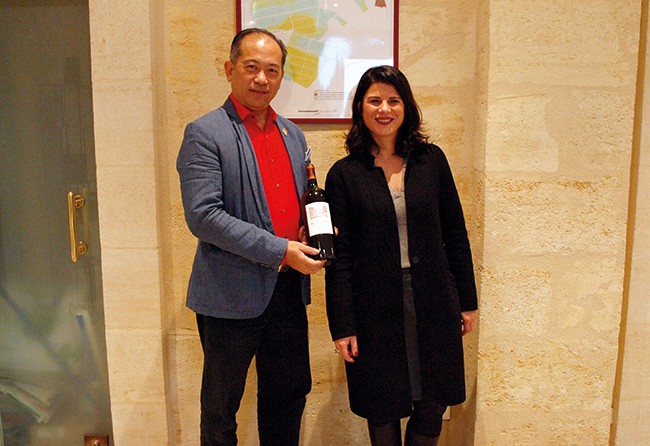
The vineyard has been purchased by CA Grands Crus in 2004. It then consisted of old vines planted at 2 meters with a high canopy. Under Anne Le Naour’s direction, the group undertook the restructuration of the vineyard whose results were visible from the 2010 vintage. Little by little, the vines are replanted at 1m60 to increase density.
The vines aged on average 25 are composed of 60% Cabernet Sauvignon, 40% Merlot, with an average yield of 45 hectolitres per hectare. The vineyard is maintained according to Bordeaux environmental management system and is certified HEV (High Environmental Value) level 3.
The château totals 97 hectares in production. The mapping made in 2014 has highlighted the presence of 4 different types of soils, which means quite a homogeneous terroir. Thus Blaignan has got quite large vats (54, from 100 to 200 hl).
The harvest is mechanical with sorting on board and the chateau uses a pneumatic press. Here the stated gola of technology is to be able to produce a quality wine at a reasonable price (retail price, 9-10€). The estate has three wines: Château Blaignan (400,000 bottles); Château Prieuré de Blaignan (80,000) which is not a second wine but stems from 23 hectares especially dedicate to it; and Quintessence (12,000 bottles), the cuvee prestige produced only in the great vintages of Câteau Blaignan. This wine is more concentrated, with a lower yield and ageing in barrels. From 1932 Blaignan is classed Cru Bourgeois.
During his visit Nelson Chow could taste an exhaustive selection of the last vintages of Blaignan’s three wines. He noted that all three have a beautiful powerful structure, lovely red fruit aromas and a good potential.
The restructuration of Blaignan is not finished. Under the careful supervision of young and dynamic Anne Le Naour, the chateau benefits from all the expertise of CA Grands Crus to range among the great Medocs.
* SME : A collective management project of the Bordeaux Wines Trade Union aiming at reducing the impact of the wineries on their environment.
Since 2004 CA Grands Crus manages the prestigious estates in Bordeaux : Château Grand-Puy Ducasse, 5ème Grand Cru Classé de Pauillac, Château Meyney, Saint-Estèphe, Château La Tour de Mons, Margaux, Château Blaignan, Cru Bourgeois du Médoc, et le Clos Saint Vincent, Saint-Emilion Grand Cru ; Château de Santenay, Bourgogne.
The nose opens up on a lovely aromatic range, notes of chocolate, jammy black currants. The palate is round and fruity, with an excellent structure and attractive tannins. Well-made, ready to drink, perfect over a lacquered pork loin.
Pleasant nose with toasted and roasted, then subtle notes of cherry and plums. Broad and delicious palate with fleshy tannins, backed by a god acidity in the finish providing freshness. Would be a good pairing with a rump of veal and morels.
Subtle nose showing delicate scents of chocolate and jammy cherry. Outstanding palate with lovely fruit agents. Fine and round tannins with good acidity in the finish. A fine and classy wine, to drink with quality dishes like a fillet of beef.
3rd Classed Grand Cru of Saint-Julien, Château Lagrange is the beautiful adventure of a historical estate (13th century) taken over by a foreign group but that kept all its character. Property of Suntory since 1983, Château Lagrange is the most remote estate of Saint-Julien from the estuary but also the highest. Visit in one of the greatest domains of the appellation.
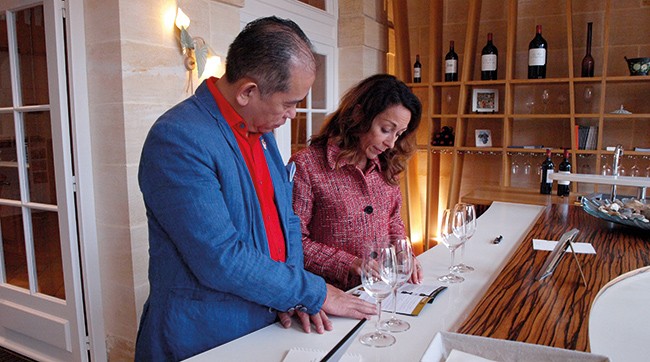
The vineyard of Lagrange covers 118 hectares in one piece located on two gravelly hilltops, representing 15% of the appellation of Saint-Julien. Planted by 67% with Cabernet Sauvignon, 28% with Merlot and 5% with Petit Verdot, it is divided into 102 plots. Replanted on 60 hectares at Suntory’s arrival, the average age of the vineyard is now of 45 years.
The challenge Château Lagrange set itself is to make great wines every year independently from the size of the domain. Through successive investment stages, the château gradually improved its facilities to give back Lagrange its glory and prestige. For 102 plots, the château now has 102 vats.
For the blends, they are advised by Eric Boissenot. PR manager Charlotte Denjean explains: “We work a lot at getting a softer and more unctuous palate.” The wines are blended in February to guarantee a better integration of the tannins and the plot origins.
In 1984, the Château creates its second wine, ‘Les Fiefs de Lagrange’, one of the oldest second wines. This cuvee is the result of a severe selection but also partially of the replanting in 1985 and 1986 of the vineyard, Les Fiefs then being made with the youngest vines. Les Fiefs is aged 14 months in oak barrels renewed by 20% every year.
Château Lagrange also crafts a white wine ‘Les Arums de Lagrange’–produced in Cussac. This cuvee benefits from 6 months maturing after fermentation in vats and barrels, and stirring of the lees. It is both mineral, herbal and fruity with a beautiful structure and the right acidity. “In Southern China the cuisine consists of a lot of fish and seafood, you need a wine with an acid and mineral profile. Les Arums de Lagrange thus matches very well”, Nelson Chow explains when he visited the estate in November. Since 2012, Lagrange produces a Haut-Médoc on 17.5 ha in Saint-Laurent-du-Médoc.
The total production of the château represents approx. 650,000 bottles. Since the implementation of optical sorting, the production is a little bit lower because of a more drastic selection of the berries. Unfortunately in 2017 the frost made lose 80% of Fiefs de Lagrange, 50% of the total production, and there is no white of this vintage.
After a tasting of the 2015s of Lagrange and Les Fiefs, Nelson Chow could discover more wines over a food and wine pairing menu prepared by Japanese chef Taichi Sato with Les Arums de Lagrange 2016, Les Fiefs 2009 and Lagrange 2009, then Lagrange 2005 and 2000.
This excellent quality reception of the sommelier was also an occasion to evoke the activity of business tourism at Château Lagrange. Fourteen guest rooms enable to welcome the professionals who come to discover Lagrange’s wines, an exclusive service in an exceptional setting (only on demand).
An address that Nelson Chow will undoubtedly remind as he comes to the Bordeaux vineyard several times a year.
Scents of cooked cherry, jammy aromas, spices and chocolate. Present round fruitiness, soft open tannins. Smooth and yet good acidity around; medium to full body. Ready to enjoy over mild food.
Toasty and roasted, rich red and black fruit aromas, excellent round fruit flavours and nice matured tannins. Full, supple, elegant body and alcohol structure. Ready to drink after 2 hours airing.
At 500 m as the crow flies from the Gironde estuary, on the hills of Valeyrac, Château Roquegrave stretches its 26 hectares on sandy and gravelly soils on alios (an iron-rich type of clay) or clay and gravels over a gravelly and stony subsoil. That is where Nelson Chow made a stopover to meet a wine grower to follow.
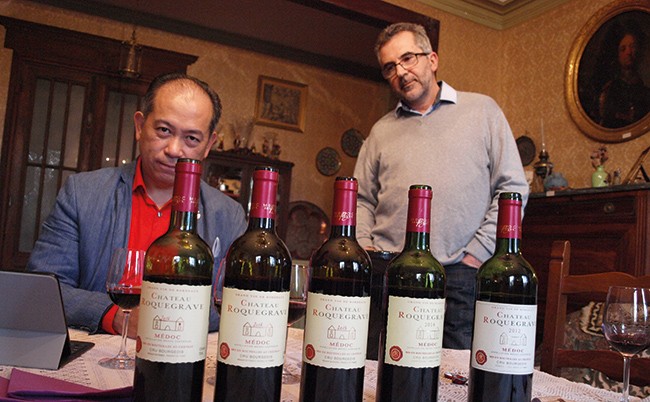
Pierre-Yves Joannon took over the family-run estate in 2016 succeeding his cousin after his father passed away. With a solid knowledge of his terroir and enological techniques, Pierre-Yves Joannon has a very precise idea of the future he wants for his estate and for the profile of his wines.
He undertook to totally restructure the vineyards with the goal to plant 70% of Cabernet Sauvignon. Aware of how difficult it is to get the good maturity of this varietal in Bordeaux, Pierre-Yves Joannon also evokes the importance of pruning to maintain the vines.
With the development of Cabernet Sauvignon, he aims at redesigning the style of the house. Pierre-Yves Joannon already works on a new cuvée, Château Haut-Valeyrac, a blend different from Château Roquegrave. For the élevage, this wine will spend one year in new barrels.
At tasting, the 2016 vintage of Château Roquegrave already shows a turn in the style of the estate. After two and a half months of skin contact, this vintage spent 6 months in white wine barrels and finishes maturing in vat. Chinese sommelier Nelson Chow notes the quality of this wine showcasing a rich fruitiness and a great maturity.
Unusual character, Pierre-Yves Joannon deserves we follow the evolution of his wine as his very thoughtful, nearly scientific approach of Roquegrave already shows lovely promises.
Cherry and berry nose with simple spices. Mild toast and coffee. Round fruity character with touch of tannin and broad finish, young fruit in mouth and fresh acid, medium light body. Easy going.
Chocolate and sweet spices, fresh blue berry, mild. Fruity and balanced mid-palate but that demands some more time to open up.
Fresh strawberry, raspberry and perfume. Rich fruit and rot fruit character, a hint of bitterness in the finish. Grape and wood tannin still strong, tight; good acidity in the finish.
Sleeping beauty located alongside the famous D2 road, the Route des Châteaux that goes along the great estates from Bordeaux up to the end of Medoc, Château Loudenne is one of the rare chateaus with a direct access to the estuary and has got its own private port. Recently Loudenne started rewriting its history and will soon be ready to bloom again.
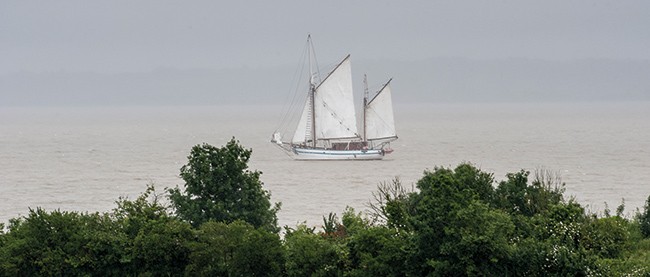
Built in the 17th century this beautiful residence had a prosperous period with the British Gilbey family (who created the Gilbey gin), the owners for 125 years. Fallen in kind of disuse Loudenne has been taken over jointly by Cognac Camus and the biggest Chinese spirits group Moutai.
Historically the spirit of Loudenne was filled with enchantment, celebration, French lifestyle. To revisit its past the new Loudenne will continue its reception mission but refocusing the services on a more selective welcoming and only for professionals. The building is currently being renovated to be given back its former splendor and glory. The park and rose garden lead in a gentle slope to the private port that will also be refurbished to enable the access to the estate by boat.
On the wines’ side, Loudenne never lost its power of attraction. The 135-hectare domain in one piece with 62 ha of vines overhangs the estuary that protects it from the extreme conditions of the climate. 46 ha are dedicated to its Médoc wine (Cabernet Sauvignon, Merlot and Cabernet Franc), 12 ha to its white Bordeaux wine (Sauvignon Blanc and Sémillon), and 4 ha to red Bordeaux. The vineyard is planted on two hills whose soils of old gravels mixed with clay on a limestone subsoil are similar to that of Saint-Estèphe.
The cellar is the playground of enologist Athanase (Thanos) Fakorellis, a specialist of white wines who also worked in Burgundy. That is why Loudenne uses barrels from coppers from Bordeaux but also from Burgundy, always French oak, lightly toasted to first preserve the fruitiness.
Visiting the estate in last November Nelson Chow noted that the reds (50% Cabernet Sauvignon and 50% Merlot) are lovely wines to keep, with a fruity, chocolatey profile and a pleasant and discreet woodiness. As for the whites (on average 75% Sauvignon Blanc and 25% Sémillon), their style is shared between the fruitiness (apricot, citrus) and minerality.
Loudenne’s new manager Philippe de Poyferré (who formerly worked at Ducru-Beaucaillou and has a long career in wine and luxury reception) admits that although there is a lot to do to restore Loudenne’s reputation the basic quality of the wines is excellent thanks to an absolutely exceptional terroir. And he says that the white and the red wines are at the same price, €20-25 retail price in France. An attractive Medoc.
Loudenne’s promise–“I will always remember”–is kept … As soon as you have tasted the wines or stayed at the chateau, a pleasant and blissful memory remains hanging in your mind just like the fog at the bottom of the small valleys in this lovely corner of the Medoc.
Chocolate, currant and toasty aromas. Open. Good fruit agents and tight powerful tannins. Lovely finish and full body. Right acidity.
Toasty nose with fruit compote aromas. Soft tannins, lovely acidity. Good freshness, harmonious body, good fruit agents in the finish.
Currant, tea leaves, nice berries in the nose. Big round fruit aromas. Tight tannins. Enjoyable now for the fruitiness.
Subtle nose with complex aromas of citrus. Lovely minerality. Firm body and solid acidity. Firm and potential wine.
On that morning, the traditional coffee and croissant has been replaced with wines of excellence for a showcase of Baron Philippe de Rothschild’s savoir-faire applied to different terroirs and chateaus that have each their specificities. To welcome Nelson Chow, Hervé Gouin, sales manager Châteaux, prepared a beautiful selection of a few recent vintages of the Baron Philippe de Rothschild estates.
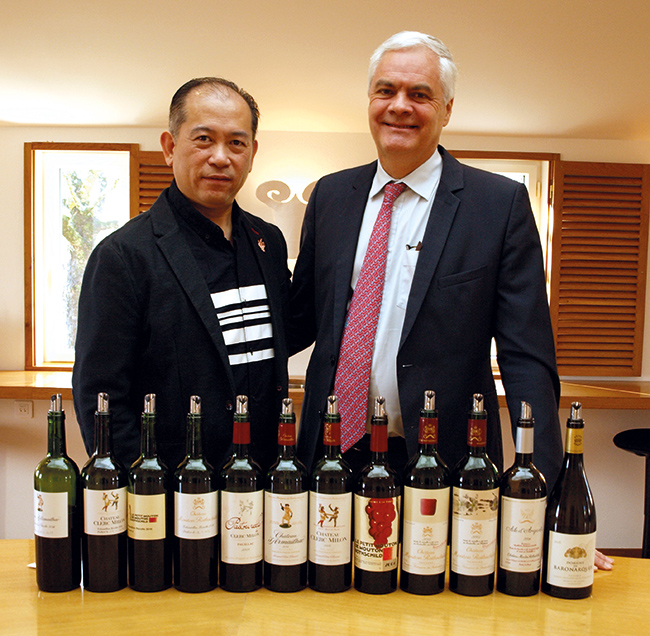
Hervé Gouin has presented samples of the 2016 vintage still maturing. A vintage that is already promising, beautiful and very fruity. At Château d’Armailhac (70 hectares), it is nearly ready to enjoy so approachable it is, creamy, fruity, after a soft first taste. In this vintage we can already feel the structure and freshness. A wine with a Cabernet profile (62% Sauvignon and 8% Franc).
Clerc Milon shows its difference with a high proportion of Merlot in the blend (up to 40% some years), an exception in Pauillac. The 2016 has only 29% but keeps an exceptional feature for the appellation, a touch of Carmenere, a variety grown by Baron Philippe de Rothschild in Chile at the Almaviva vineyards.
This varietal provides a spicy, chocolatey signature to the wine. Nelson Chow already notes how expressive this wine is at this stage of the élevage.
The discovery of 2016 continues with Château Mouton Rothschild. Stemming from a warm terroir Mouton is a fruity wine. This vintage consists of 83% Cabernet Sauvignon and 15% Merlot added with a touch of Cabernet Franc and Petit Verdot. It is a sophisticated vintage with creamy tannins. At the same time, we can feel its freshness, acidity and imposing structure. Hervé Gouin shares that the 2016 of Mouton Rothschild cannot be compared with the 2005, 2009 or 2010 as it has its very own tannic signature.
Hervé Gouin then chose Château d’Armailhac 2011, an often underestimated vintage but that is very enjoyable now. A fine, very elegant nose, a classical Pauillac.
Then, in order to show the evolution of Clerc Milon, Nelson Chow could come back on a 2006. The estate then still used to work with the old vats. A wine with a powerful tannic structure, stricter and less sophisticated than the current Clerc Milon but that still is very promising for the future. After a detour by Petit Mouton 2004 (the second wine made of from a selection of vats of Mouton Rothschild)–the best vintage ever of this wine according to Hervé Gouin and a wine for connoisseurs for its complexity–back to Mouton Rothschild with 2013. A year with a difficult harvest due to the humidity and disease, 2013 however is a pleasant vintage, little concentrated, “perfect for the restaurants thanks to a very interesting quality-price ratio” Hervé Gouin underlines, a wine that would be perfect over fish like a sole or lobster.
The tasting culminated with the 2005, still young, to decant one hour before. It offers the complexity of the greatest of its rank, a delicate first taste with notes of tobacco, toasty and chocolatey aromas, cassis and still firm tannins.
After a short trip to Languedoc with the Baronarques 2016, 100% Chardonnay, stemming from 7 hectares in AOC Limoux, Hervé Gouin concludes this wonderful degustation with Aile Aile d’Argent*, Château Mouton Rothschild’s white. The house explicitly wants to produce the most Burgundian Bordeaux, with a rich profile, full body, a buttery, not too mineral nor to straightforward wine. The 2016 is a blend of 53% Sauvignon and 46% Sémillon with a hint of Muscadet, aged in small barrels with stirring of the lees.
And to engrave the art of winemaking according to Mouton Rothschild in his mind, Nelson was led through the exhibition of all the sketches and labels of every vintage of the chateau since 1945.
* Aile d’Argent is the name of the main character of a tale written by her father for Philippine de Rothschild when she was a child.
Aromas of chocolate, sweet & mild spices, nice cassis. Tight tannins, supple body, medium and fresh acidity. Can be enjoyed over with food from now.
Lovely aromas of currants, plum, dark fruits, jammy, toasty and chocolatey. Ripe tannins with a nice balance of the acidity and the fruitiness. Full and powerful body. A lot of layers of flavours. Can wait for 2 more years.
Property of Martin and Olivier Bouygues, Château Montrose is renowned for its commitment in the respect of the environment. Far from being a simple marketing signature, at Montrose, ecology is a genuine collective consciousness, a vision of the future adopted unanimously by the entire team.
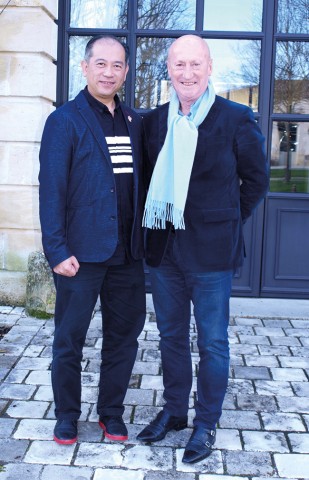
Initiated by the Bouygues brothers, the management of the ecological revolution at Montrose is driven by CEO Hervé Berland. It is not about being in compliance with the rules of organic farming, of adherence to CIVB’s Environmental Management System or about High Environmental Quality certification, these achievements are nearly prehistoric in the scale of the ecological approach of Montrose. Here the objective ‘zero impact’ on the environment guides everyone’s actions from the vineyard to the cellars. At Montrose they reached a scientific level in the respect of the plant, the earth, and in fine of the men who work them.
Since 2014, Montrose uses drones to scan the vineyard. A precise mapping has been done and enabled to identify 22 ‘climats’ like in Burgundy. The definition of these plots of land permits an extreme precision in the management and supervision of the vines, then the harvest during which the pickers sometimes pass 5 times in some areas. No unnecessary action, no loss of material nor grapes. The estate also bought an electric tractor. An ecological wonder. No release into the atmosphere, silent, made with recycled and sustainable material, a light weight so no soil and root compaction.
This level of precision is also the standard in the cellar of course. Reduced maceration time, lower fermentation temperature, drastic selection of the press wines, an extreme care to details is set in the service of the finesse and elegance of the wines. Though the primary goal of this approach at Montrose is to produce a wine worth its rank–even beyond–, the ultimate intent, the objective shared by all at Montrose, is to transmit a land made free from pollutants, to recreate a biosphere that would not have suffered from human interference, to live in harmony again with nature. Maybe beyond the understanding of the most conventional, Montrose imagines a new era where man, nature and new technologies live in synergy.
Hervé Berland has a dream: set technology in the service of the vine with an accuracy down to the leaf. Imagine a machine that would scan plant by plant and would know the exact minimum amount needed to cure it, and only if necessary. Futuristic? Not that much, researches are in progress on many subjects.
And if we too dared to dream of such a futuristic world? Why not imagine to repair with organic 3D printing the vine stocks that have suffered from the weather and the diseases?
In the nose chocolatey, toasty, roasted nose with cinnamon and cloves. Cherry and cooked berry. Soft creamy tannins, still tight, and good balance of the body and the acidity. Round fruitiness.
Solid ruby-red colour. In the nose, aromas of cherry and plummy fruits, clove and peppery spices. Toasty. Round soft tannins, still a bit tight, round jammy fruits in the mouth and yet a good acidity in the background. Quite a young wine but can start drinking with the good preparation.
Young ruby red colour with purple rim, bright and clear. Jammy fruit aromas, cassis and plum, sweet spices and great roundness in the nose. Opulent fruit agents, round and cheering, solid tannins but ripe. Long lasting in the mouth, big powerful body and good acidity. Needs decanting and airing before drinking.
Already registe–red by the Féret guide in 1874 Château Brillette is a lovely domain of 100 hectares out of which 43 of vines, taken over by the Flageul family in 1975. Its name is inspired by “briller” [shine] like the sun that reflects on the little gravels of the vineyard. Attracted by this peculiar brightness thanks to a lovely sunset, Nelson Chow came to taste the château’s wines.
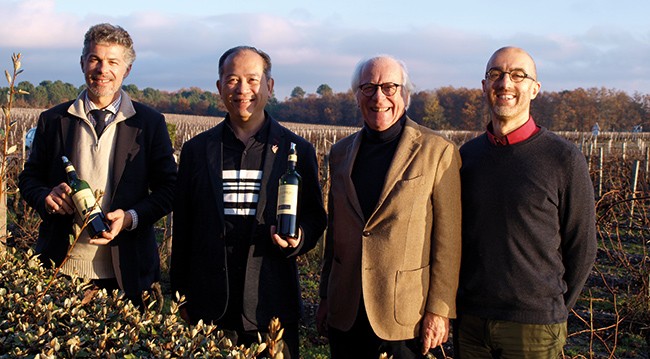
Wine is a family matter. Romain Flageul and his father take care of the château whereas his brother Erwan runs a trade house in Bordeaux. The château produces two wines, ‘Château Brillette’ Cru Bourgeois and ‘Les Haut Brillette’, both Moulis-en-Médoc wines.
The vineyard is located on good gravelly hilltops on the highest point of the village. The clay subsoil enables to get a natural regulation of the water supplies. The planted varieties are 48% Merlot, 40% Cabernet Sauvignon, 9% Cabernet Franc and a bit of Petit Verdot (3%). They are currently planting more Cabernet Sauvignon to tend to a proportion of 50% Merlot and 50% Cabernet Sauvignon. The density is willingly high (7,200 stocks per hectare). The vineyard is managed sustainably with an increasing concern for the protection of the environment.
In the cellars, Château Brillette works with plot selection by micro-terroirs from the vats to the barrels. The press wines are also carefully selected. The wine ages in oak barrels (30 to 50% new every year) for 12 months on average. Brillette’s wines can be kept up to 15 years, “the 2000 is really beautiful now” confirms Romain Flageul.
Château Brillette’s markets are France and 15% at export, mainly to Asia. Welcoming Nelson Chow, Romain Flageul of course asked for the expert’s opinion about his grand wine in 2016, 2015, 2013, 2010 and 2009.
They spent a long time tasting the 2009 and 2010. Romain Flageul cannot hide his satisfaction about both vintages that have great success. “We kept some 2009 and 10 for the restaurants in Paris as they are not on the market anymore.”
Château Brillette is a welcoming place. It was a pleasant and warm stopover for Nelson Chow and the promise was made to soon meet Romain Flageul in China.
In the nose, aromas of cassis, roasted, toasty, coffee with a nice savory character. Full body, big round fruitiness and great acidity. Firm tannins that start to be creamy. The wine is getting ready to be fully enjoyable.
In the nose, cassis and cherry with plummy fruits, sweet spices, herbs. Big round fruit, open. Tight tannins on a smooth basis. The right level of acidity. Still a lovely potential.
— — — —— — — — — — — — — — — — — — — — — — — — — — — — — — — — — — —
Created in 1934 the cooperative cellar Vignerons d’Uni Médoc is the first producer of the Medoc AOC with 20% of the total volume. Top-notch technology, certified processes, flexible on-demand vinification and a commitment in sustainable development are added to the human and fraternal dimension that is the very essence of the notion of cooperation.
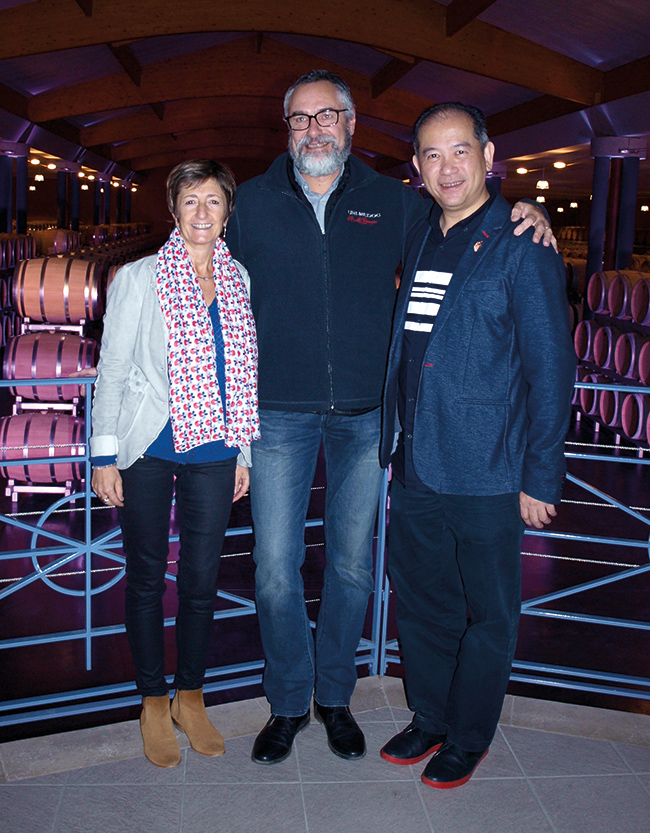
Uni Médoc is currently the biggest cooperative in Medoc with a total production surface area of more than 1,000 hectares. 55% of the production is bottled i.e. 4 million bottles a year out of which 40% are exported (1st market, USA, followed by China, Germany and Belgium). Sometimes a bit to Africa.
For an optimum quality of the handling of the grapes the cooperative has 3 vinification wineries. Uni Médoc has a total vatting capacity of 200,000 hl and integrates its own bottling, labelling and packaging line. Part of the wines are aged at the cooperative, in 3,600 oak barrels (1/3 renewed every year). The production is followed and controlled by 3 technicians.
Impressive premises. But the cooperative’s technical manager Laurent Vaché, also administrator of the Medoc defense organization and vice-president of Alliance des Crus Bourgeois, explains that the cooperative first unites winegrower families (nearly 200). And says: “One has to understand that the cooperative does not aim at making profit. We do not deal with capital management and we nurture a real human dimension”. A conviviality that Nelson Chow could notice during his visit in last November.
Nelson Chow was welcomed by the cooperative’s manager Xavier Deval and Olivier Sempé, the new sales manager, with a guard of honour of cuvees representative of the work done by different member winegrowers. Twelve wines from 2014 to 2016 have been submitted to the expert palate of the Chinese sommelier.
To finish the degustation, Laurent Vaché presented a blend made by the cooperative, Esprit d’Estuaire. It is produced on 15 hectares among the best plots of the member wine growers. At last Nelson Chow could discover Château Clément Saint Jean, one of the four properties of the cooperative, a Cru Bourgeois benefiting from a vinification and élevage worth a Grand Cru. As for the Réserve 2014, a 100% Cabernet Sauvignon, it aged for 18 months in barrels and represents the long ageing wine of the cellar. The cooperative has also just taken over a small vineyard in Haut-Médoc where they expect to produce the first vintage in 2018.
Uni Médoc made a point of improving their wine touristic attractiveness. The cooperative and its shop are located in Gaillan on the main road that crosses the Medoc from Bordeaux to Le Verdon. The shop generates 8% of the cellar’s turnover. The visitors are welcomed by the winegrowers themselves on every Sunday and bank holidays. Since 2016 the barrel cellar hosts a sound and light show to which you are invited before even tasting, in order to set you in the special atmosphere of Medoc, the “Middle-earth”, between ocean and estuary, and prepare you to properly enjoy the wines presented by the producers in the shop.
If you ever pass on this road, have a break to meet them. The sense of hospitality, conviviality and eagerness to share, intrinsic to wine, takes on its full meaning here.
Dark cherry and jammy fruit, sweet spices and coffee in the nose. On the palate, a round fruitiness, nice soft tannins. A complete wine. Good acidity. Great potential but nice to drink now.
Chocolatey and toasty characters, sweet spices, blackcurrant and coconut. Round fruitiness, full body and ripe tannins though still tight. Sweet fruity wine good for drinking now but with a potential for a few more years.
The wine needs no airing. Chocolatey, toasty, strong cassis and cherry scents. Good round fruity character on the palate and great balance of the fruit and body structure with soft tannins. The acidity is there to keep the wine lively. Ready to drink and a potential for the coming 5 to 8 years.
By a beautiful morning of autumn Nelson Chow discovered this lovely estate in the Médoc AOC. Nestled under the shade of 18th-century plane trees, the château produces two wines with one bearing a name that evokes this romantic setting, Château Amour.
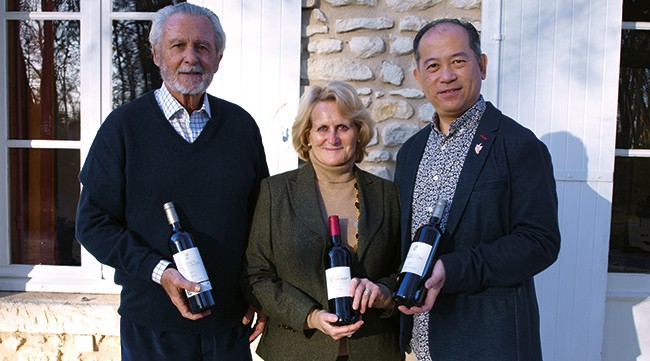
It is an estate of the 19th-century, family-owned since 1930, run since 2006 by Corinne, the daughter of the former owners, and her husband Georges Dadda. From their arrival, the couple has modernized the premises to improve the quality of the wines. Though for the history they kept the old oak vats, the Daddas replaced it by a modern vathouse in another building. Chosing an eco-friendly approach, they got the HEV certification in 2016.
The estate stretches over 90 hectares out of which 53 in production. The position of the vineyard at the crossroad of the influences of the ocean and the estuary offers it a nearly blessed situation. In 2017 especially, Panigon has not suffered from the frost whereas their neighbour has been hit by 95%. The vineyard is planted with 45% Cabernet Sauvignon, 50% Merlot and 5% Petit Verdot, blooming on hills of gravels among the best terroirs of the Medoc.
The estate produces two wines, both classed Cru Bourgeois, Château de Panigon for the touch of elegance, and Château Amour for the passion. Each cuvée represents approx half of the total yearly production of 350,000 bottles. Panigon is a blend of 50% Merlto, 45% Cabernet Sauvignon and 5% Petit Verdot. It is aged for 14 to 18 months in oak barrels (30% new). Amour is a 50/50 Merlot-Cabernet Sauvignon aged in oak barrels for 12-14 months.
Corinne and Georges Dadda are specially attracted by China as she lived there and the couple are very interested in Asian gastronomy. Therefore they were pleased to welcome Nelson Chow in last November.
After he tasted Château de Panigon and Château Amour 2015 and 2014, the Chinese sommelier immediately noticed the difference of character between both wines. Château Amour is fruity, supple, easy to drink,. A wine easy to pair. Nelson Chow advises to serve it over Sichuanese cuisine, very spicy.
Château de Panigon also develops fruity aromas but also spicy and toasty notes with a fuller body, a wine to keep in the cellar. It will be good over Shanghainese cuisine that uses more soy, dark vinegar and sugar. The sommelier underlines however that these two cuvees share an obvious common signature that is probably to the terroir.
The wines of the estate are exported by 80%. If you want your share of ‘Amour’ make a detour in this lovely corner of Medoc where you will be simply and warmly welcomed.
Cassis and sweet spices, chocolate and tobacco. Medium body with tight tannins, round fruit and good acidity. An easy wine to pair, good for Sichuan cuisine with all spices including hot spiced dishes. It could be good with some meat in the south of China too, for example sautéed beef slices with oyster sauce.
Mild spices, cherry, touch of mint. Still a bit closed at the moment. Round fruits with a nice acid background. Tight soft tannins, powerful body. Good to enjoy now and can keep for many more years to come. It is easy with Shanghainese cuisine which has more soy and sweet characters and an oily texture.
The Allard family took over the domain in 2009. The father Christophe and his son Louis changed life and turn themselves into wine growers which is not their profession. When they arrived the château was in a poor state and had lost its past glory. They started a long work of restructuration and rebuilding to give back its repuration to Sigognac classed Cru Bourgeois in 1932 but whose history dates back many centuries.
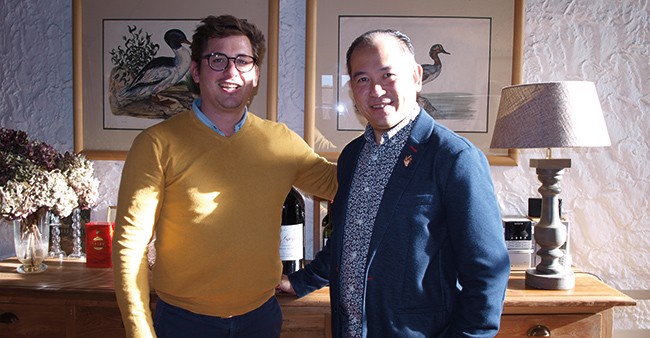
The very old vineyard comprises very old vines of forty years old but it was in a very poor state when the Allard family arrived. They thus started to replant and restructure to make it more homogeneous. The planted varieties are shared between Merlot (70%) and Cabernet Sauvignon (30%) on 50 hectares around the château. The growing methods are traditional but trials in organic have started on 1.5 hectares with an objective of 10 hectares.
In the very old vathouse there are still very old oak tuns that are not used anymore. The vinification and blending are undertaken in stainless steel and concrete vats. For he ageing, Château Sigognac uses 18-month-old barrels (coming from Ducru Beaucaillou) rather than new barrels as the family prefers to focus on the fruitiness.
The estate has three wines: Château Sigognac (150,000 bottles), a second wine ‘Benjamin’ (50,000 bouteilles) and a confidential cuvée ‘Enclos de Sigognac’ (3,000 bouteilles) stemming from very old vines aged 80 and results from integral barrel vinification. The range also includes a small production of white and rosé. The family is helped by enologist Eric Boissenot.
Behind this definitely Medoc classicism and respect of the tradition, you can find a young delightful man, Louis Allard, a new generation that has the courage to start all over with a new huge adventure. And therefore it is worth a trip to go and discover these lovely wines of passion and pleasure.
Young cherry, smoky and sweet spices, light, a touch of mint. Soft tannins and open, nice acidity at the back, but round and fruity character already coming up. A nice balance. Ready to drink.
Aromas of chocolate and coffee, dark cherry and plum, tea. Round fruitiness, fresh acidity and medium body, tight tannins. A complete wine ready to drink. Nice wine with potential.
Cool cherry nose, a touch of mint and sweet spices, chocolate. Big round fruitiness, nice ful body, strong and tight tannins. A wine with potential wine already approachable now.
The cooperative winery La Rose Pauillac is a beautiful example of resistance and conviction. Through successions and in front of land pressure, many wine growers have sold their vineyards to the chateaus of the appellations and nowadays the cooperative has only 25 members for 25 hectares.
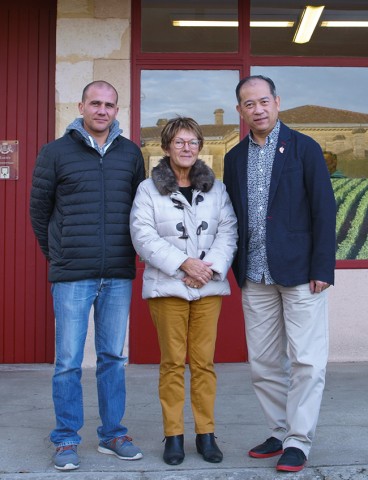
Nelson Chow took the opportunity of his trip in Medoc to come and discover this cellar whose name sounds as romantic as prestigious. Presided over by Sylvie Rainaud since 2001, the only cooperative of the AOC, created in 1933, is a beautiful example of solidarity in resisting the economic steamroller. Nowadays they are 25 wine growers representing 25 hectares to provide their grapes to the cellar.
La Rose Pauillac proposes 3 labels: La Rose Pauillac, La Rose Pourpre and Château Haut de la Bécade, for a total yearly production of 150,000 bottles. These three wines have a very different profile which enables to meet diverse expectations and consumption moments.
The cellar is perfectly equipped to meet the most demanding quality requirements. Vinification is undertaken in concrete vats that have the particulatiry to be built on three levels. The ageing is done in barrels renewed by third every year.
La Rose Pauillac is the cellar’s grand wine. Aged in oak barrels it is well-structured, powerful, dense and is the perfect expression of the terroir of Pauillac, and is worth ageing. La Rose Pourpre is made with Cabernet Sauvignon et Petit Verdot mainyl with a touch of Cabernet Franc. A more atypical profile that benefits from an 18-month ageing in barrels. Château Haut de la Bécade stems from 6.5 hectares in the village of Bâges; it has a long ageing capacity.
In the nose, scents of cassis, blueberry jam, sweet spices, coffee bean and liquorice. Beautiful round fruitiness with a fresh acidity. Soft but still tight tannin. A good potential.
Mint and mild spices, nice cassis and cherry nose. Tight and powerful tannin with full body and nice fruit agents, just ok acid. Can be kept and wait for 2 more years before enjoying.
Scents of chocolat, sweet spices and caramel in the nose with cassis and cooked berry. A good round fruitiness with tight sweet tannins and a good acidity, all well-integrated. Full body. Can be enjoyed now but better wait for another 5 years.
Very young purple colour. In the nose, mint, herb, spices, cherry and blueberry, some smoky and toasty characters. A powerful body with an elegant fresh acidity, nice fruit aromas. Good overall balance. Tannins are firm and ripe. Can be kept for 5 to 8 years more.
Mint and spices in the nose, young cherry and currant fruit scents. Full body with nice acidity and young fruit flavours. The wine can be kept but you can also start to enjoy in now.
Sylvia van der Velden